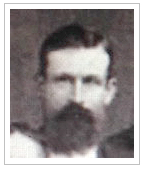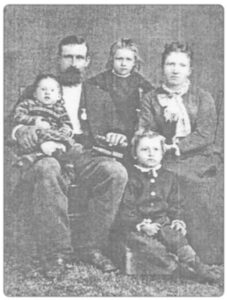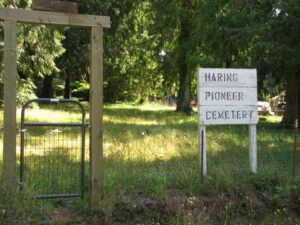Amos L. Haring
North Fork Pioneer
He built a small two-room structure of hand split cedar with one window and a door opening, but no door. Muslin was used to cover the window, and a blanket was hung over the doorway. There was no floor. In 1879 he brought his wife Clara and 2 children to live on the homestead and they became the first European family on the North Fork.
 Amos Haring’s independence began early in life. His father David, was a carpenter on a merchant seaman ship traveling between the West Indies, Europe and U.S. seaports. This has caused some confusion as to where Amos was born. Some documents indicate he was born aboard ship on one of those trips. Other documents report he was born in New Jersey where his parents settled. Whatever the circumstances were, it is clear he embraced life aboard a vessel at sea. At the age of 9, Amos declared he had no interest in school. Instead, set sail with an uncle, first as a cabin boy, then as a sailor aboard a spice ship. He lived aboard ship for 10 years. His exact history at this point varies. Some say after a trip around Cape Horn, the boat he was on docked in San Francisco. He supposedly chose to remain there for a time before relocating to Coos Bay. Amos’ granddaughter Ella Vanderburg however, tells a different story. She recalls being told when Amos was 19 years old, he was the lone survivor of a shipwreck. The event occurred while he was aboard a boat which hit a reef and tragically, all on board fell into the water. Amos held onto the mast which remained partially out of the water and climbed to the end of it. From there, he could see no others except for a bit of red far below the surface. He guessed it may have been from the red calico dresses last worn by the captain’s wife and daughter. He slit the sail for a make-shift hammock and cut a portion of the cloth to catch rain water. He remained attached to the boat’s mast for 7 days, having nothing to ingest but rain water. Finally, when a boat happened by, he had become so weak and weary. He could barely muster enough strength to let go of the mast and fall into the rescuing boat. He was taken to Coos Bay (then named Empire City) where he recovered and continued to live. For Amos, the experience was but a prelude to a remarkable life that followed.
Amos Haring’s independence began early in life. His father David, was a carpenter on a merchant seaman ship traveling between the West Indies, Europe and U.S. seaports. This has caused some confusion as to where Amos was born. Some documents indicate he was born aboard ship on one of those trips. Other documents report he was born in New Jersey where his parents settled. Whatever the circumstances were, it is clear he embraced life aboard a vessel at sea. At the age of 9, Amos declared he had no interest in school. Instead, set sail with an uncle, first as a cabin boy, then as a sailor aboard a spice ship. He lived aboard ship for 10 years. His exact history at this point varies. Some say after a trip around Cape Horn, the boat he was on docked in San Francisco. He supposedly chose to remain there for a time before relocating to Coos Bay. Amos’ granddaughter Ella Vanderburg however, tells a different story. She recalls being told when Amos was 19 years old, he was the lone survivor of a shipwreck. The event occurred while he was aboard a boat which hit a reef and tragically, all on board fell into the water. Amos held onto the mast which remained partially out of the water and climbed to the end of it. From there, he could see no others except for a bit of red far below the surface. He guessed it may have been from the red calico dresses last worn by the captain’s wife and daughter. He slit the sail for a make-shift hammock and cut a portion of the cloth to catch rain water. He remained attached to the boat’s mast for 7 days, having nothing to ingest but rain water. Finally, when a boat happened by, he had become so weak and weary. He could barely muster enough strength to let go of the mast and fall into the rescuing boat. He was taken to Coos Bay (then named Empire City) where he recovered and continued to live. For Amos, the experience was but a prelude to a remarkable life that followed.
Amos met and married Clara Gamble in Coos Bay in 1874. That December after several days of bad weather, the Coos Bay channel was deemed too dangerous for passage by vessels. Schooners and steamers were forced to remain docked. By January 3rd, with the bar appearing calm, the tugs Escort and Fearless set out to survey the channel. Several schooner captains anxious to depart, boarded the tus as well. While in front, the Escort tug was struck with a heavy breaker washing over its deckhouse and all on board. Captain A.L. Nisson (of the schooner Twilight) was swept overboard and seen swimming astern in the breakers. Life preservers and lines were thrown overboard, but to no avail as he was carried further away. In a rescue attempt, the other tug approached broadside to the breakers, but was unsuccessful in reaching the captain. By then he had been in the water for 20 minutes and struggling to stay afloat. The tug’s captain asked his mate Amos Haring, to jump overboard with a heaving line. Amos did so and was able to grab onto Captain Nisson. Just then a breaker struck the tug pushing it on top of the two men in the water. Amos was pulled aboard, but Captain Nisson was never seen again. Master Mariners Benevolent Association awarded tug Captain James Hill and Amos Haring gold medals for their heroic 1875 rescue efforts.
 Amos and Clara had two children and resided in Coos Bay for several years. One day while on a hunting trip, Amos discovered an area of land along the Siuslaw River’s North Fork. The area had recently become open for settlement. The Donation Land Act of 1850 provided free land to white settlers intending to clear, improve and live on it. At the time, the Siuslaw area was still an Indian reservation. No white people lived there until the government opened the valley for settlement. The Siuslaw Indian village was located near the present-day North Fork bridge. The day Amos first saw the area, only one white settler had established a homestead on the North Fork. Nonetheless, the area made such an impression on him, he filed for a 160-acre homestead claim, To file, he walked through the mountains of the Coastal Range, and south to Roseburg, a 300-mile round trip. He built a small two-room structure of hand split cedar with one window and a door opening. There was no door, so muslin was used to cover the window, and a blanket was hung over the doorway. There was also no floor. In 1879 he brought his wife Clara and 2 children to live on the homestead, They became the first European family on the North Fork. Until the farm was established, Amos fished and returned to work on boats or schooners to supplement his family’s income.
Amos and Clara had two children and resided in Coos Bay for several years. One day while on a hunting trip, Amos discovered an area of land along the Siuslaw River’s North Fork. The area had recently become open for settlement. The Donation Land Act of 1850 provided free land to white settlers intending to clear, improve and live on it. At the time, the Siuslaw area was still an Indian reservation. No white people lived there until the government opened the valley for settlement. The Siuslaw Indian village was located near the present-day North Fork bridge. The day Amos first saw the area, only one white settler had established a homestead on the North Fork. Nonetheless, the area made such an impression on him, he filed for a 160-acre homestead claim, To file, he walked through the mountains of the Coastal Range, and south to Roseburg, a 300-mile round trip. He built a small two-room structure of hand split cedar with one window and a door opening. There was no door, so muslin was used to cover the window, and a blanket was hung over the doorway. There was also no floor. In 1879 he brought his wife Clara and 2 children to live on the homestead, They became the first European family on the North Fork. Until the farm was established, Amos fished and returned to work on boats or schooners to supplement his family’s income.
By the end of 1881, the Haring’s welcomed two more daughters, Emma and Rachel. Emma was the first white child born on the North Fork. Rachel was born on Christmas day, but before her second birthday drowned in the nearby river. In October, 1890 their son Benjamin Thomas fell from a tree striking his head on a log. The fall did not appear to be serious at first, as he continued playing the rest of the day. However, the next morning he complained of a severe head ache which persisted throughout the night. Sadly, he died the following day at 7 years old.
10 years after the Haring’s settled on the North Fork, white people began arriving. They settled in Florence, Acme, Mapleton and along the creeks of the Siuslaw. According to daughter-in-law Gladys (Gentry) Haring, in 1912 a project to establish a road between Eugene and Mapleton began. Amos and other local men volunteered to do “donation work” for 3-month periods to help. For a number of years, men took turns with the donation work. While doing his part, Amos came down with pneumonia so severe, he nearly died.
Amos Haring eventually became a successful dairy farmer. It is said he brought the first cattle to the Florence area. This proved to be an arduous task for both himself as well as the animals. They were transported from Coos Bay by boat, then herded up the beach. They had to be coaxed to swim across the Siuslaw River to reach their final destination on the North Fork farm. With a growing farm, Amos and Clara built a two-story home to accommodate their expanding family of 9 children.
 Amos set aside a section of land to bury his two deceased children (Rachel and Benjamin). In 1968 his daughter Agnes Haring McCormack had the section officially surveyed and designated as the Haring Pioneer Cemetery. In addition to the two deceased children, most of the Amos and Clara Haring family members and many other pioneers have been laid to rest there.
Amos set aside a section of land to bury his two deceased children (Rachel and Benjamin). In 1968 his daughter Agnes Haring McCormack had the section officially surveyed and designated as the Haring Pioneer Cemetery. In addition to the two deceased children, most of the Amos and Clara Haring family members and many other pioneers have been laid to rest there.
Amos and Clara Haring made significant contributions to the history of Florence. They established both early trade with the Siuslaw Indians, and a one room Portage Schoolhouse. Clara served as mid-wife and delivered over 100 babies during her lifetime. Read the Clara Haring story to learn more of her remarkable pioneer life.
